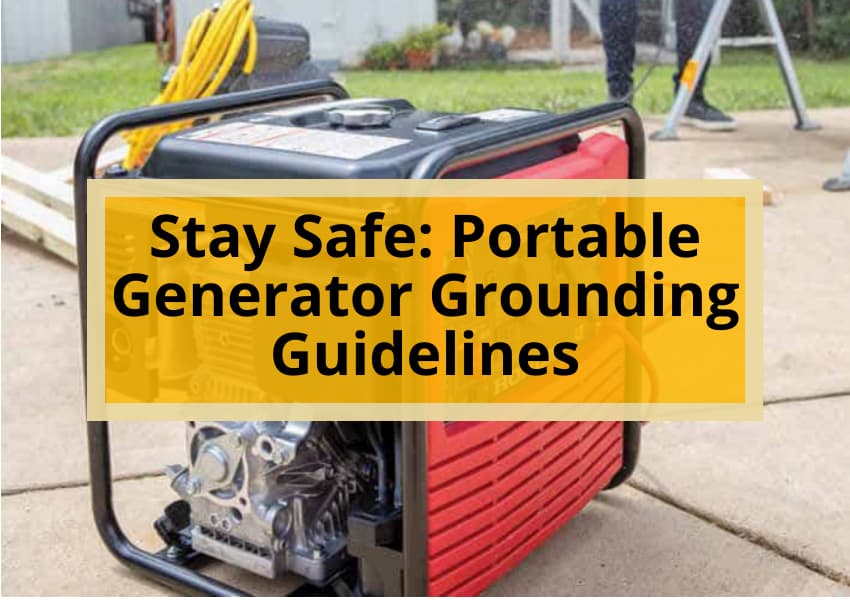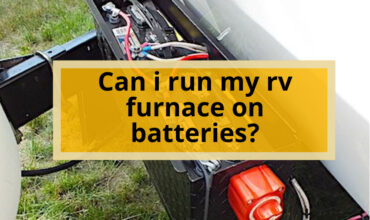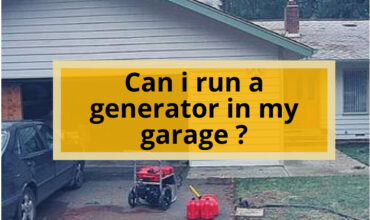Are you ready to stay safe while using your portable generator? Grounding it is crucial. Not only does it prevent electrical hazards, but it also protects you from shocks, fires, and equipment damage.
OSHA guidelines require all generators to be grounded, so it’s important to check the manufacturer’s recommendations too. In this article, we’ll guide you through the step-by-step process of grounding your generator and discuss the risks of not doing so.
Join us and ensure a safe and worry-free generator experience.
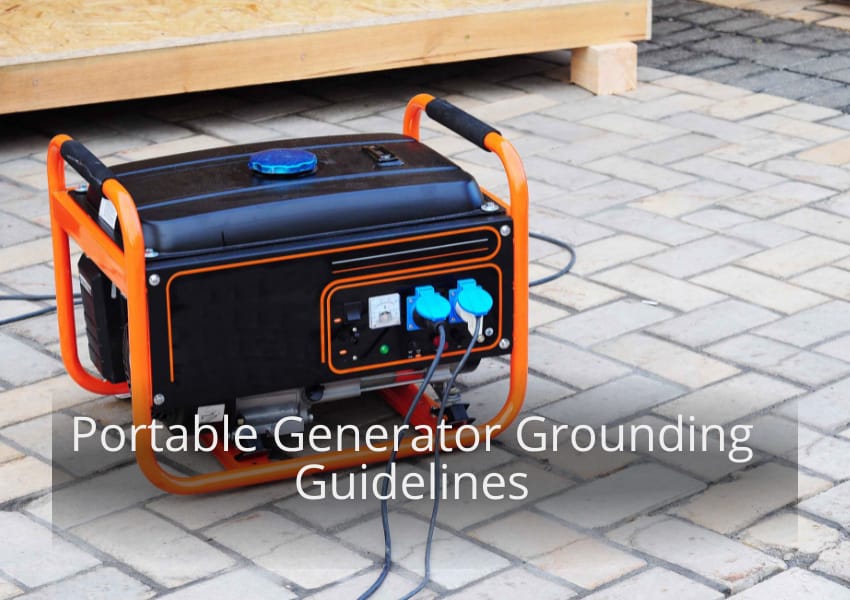
The Meaning and Importance of Grounding Your Portable Generator
Grounding a portable generator is an important safety measure that involves connecting its electrical circuit, specifically the generator’s frame, to the ground. This ensures the safe transfer of remaining currents and helps prevent electric shocks. To accomplish this, a low-resistance metal wire is used to connect the generator’s neutral electric conductor terminals to the ground.
There are different grounding techniques that can be used, including lightning protection, system or neutral grounding, using ground rods, and bonding. Lightning protection is used to shield devices from damage caused by lightning strikes. System or neutral grounding connects equipment to the ground through the neutral part of the circuit.
Grounding a portable generator is essential to prevent hazards such as electrical overload, electrocution, fires, and explosions. It is important to determine the need for grounding based on OSHA guidelines and manufacturer recommendations.
To safely ground a portable generator, you will need tools such as a grounding rod, copper wire, wire stripper, hammer, pliers, wrench, and protective fittings or clamps. The process involves installing the ground rod, stripping insulation from the copper wire, coiling the wire around the grounding rod, and attaching it securely to the generator’s grounding bolt.
When camping, the process of grounding a generator is the same, but it’s important to lay the copper wire away from the campsite and use a heavy-duty four-wire cord for connection to an RV.
By grounding your generator, you comply with safety regulations and codes, minimizing the risk of electrical accidents and extending the lifespan of your generator.
A Step-By-Step Guide on The Best Way to Ground a Portable Generator
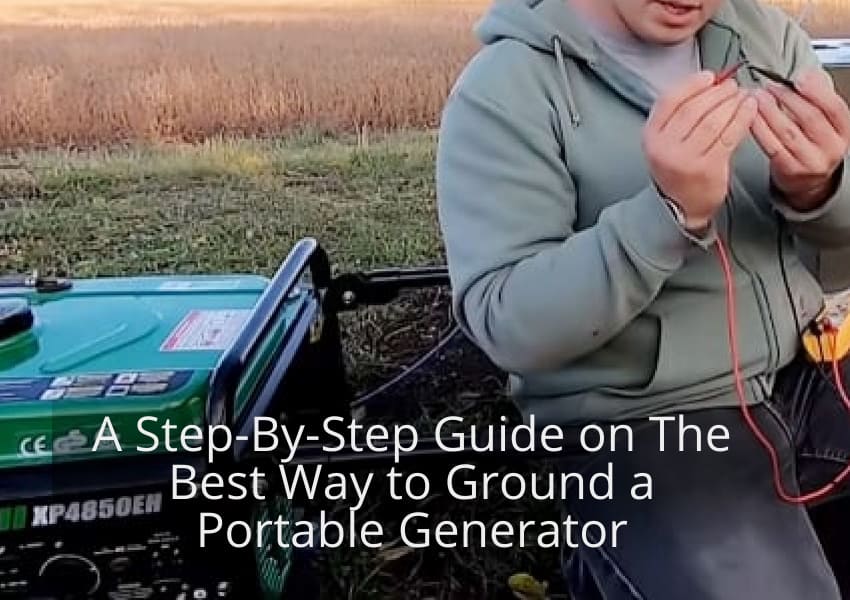
To ensure the safe and proper grounding of your portable generator, there are several key steps you need to follow.
Following these steps will help ensure the safe and effective grounding of your portable generator.
1. Determine The Generator’s Grounding Requirements
The owner’s manual will provide detailed instructions on whether grounding is necessary and how to properly ground the generator. Following the manufacturer’s recommendations is crucial for maintaining the integrity of the electrical system and preventing potential hazards.
By adhering to the grounding guidelines outlined in the owner’s manual, you can belong to a community of responsible generator users who prioritize safety.
Take the time to familiarize yourself with the specific grounding requirements of your generator to ensure a secure and reliable power source.
2. Prepare The Grounding Rod
Now that you have determined the grounding requirements for your portable generator, the next step is to prepare the grounding rod. The grounding rod plays a crucial role in establishing a safe electrical connection to the Earth.
It serves as a connection between the generator and the earth, providing a low-resistance path for electrical current.
· Tools
First, gather the necessary tools for this task, including a grounding rod, copper wire, wire stripper, hammer, pliers, wrench, and protective fittings or clamps.
· Choose A Suitable Location
It is crucial to find a location that is away from any flammable materials, such as gasoline, propane tanks, or dry vegetation, to minimize the risk of fires.
Additionally, the surface should be stable and level to ensure the generator remains in place during operation. Avoid placing the generator on uneven or wet surfaces, as this can affect its stability and potentially cause accidents.
· Drive The Grounding Rod
Using a hammer, drive the grounding rod into the ground until it is fully inserted. The rod should be installed at a depth of at least 8 feet and at a slight angle away from the generator. This ensures optimal grounding effectiveness and stability.
Make sure the rod is securely in place and tightly packed with soil to maintain a solid connection. Properly driving the grounding rod is a critical step in ensuring the safe and effective grounding of your portable generator.
3. Connect the Grounding Wire
After driving the grounding rod, securely attach the grounding wire to the generator’s grounding bolt. This step is crucial to ensure the proper grounding of your portable generator.
Begin by selecting a suitable grounding wire that is of appropriate size and material. Strip the insulation from the wire using a wire stripper, and then tightly coil the copper wire around the grounding rod using pliers. Make sure the coil is secure and tightly wound.
Next, locate the grounding bolt on the generator and insert the end of the wire into the bolt. Use a wrench to tighten the connection securely. This will establish a solid connection between the generator’s frame and the grounding system.
It is important to ensure a tight and secure connection to prevent any disruptions in the grounding process. By following these steps, you can safely and effectively connect the grounding wire to your portable generator, ensuring proper grounding and minimizing the risk of electrical hazards.
4. Connect The Other End of The Grounding Wire to The Rod
Now that you have connected one end of the grounding wire to the generator’s grounding bolt, it’s time to connect the other end to the grounding rod. This step is crucial in completing the grounding process and ensuring the safety of your portable generator.
Using your pliers, tightly coil the copper wire around the grounding rod. Make sure the wire is securely attached to the rod to provide a low-impedance path for current. This connection will allow any excess electricity to flow safely into the ground.
By connecting the other end of the grounding wire to the rod, you are effectively creating a direct pathway for electrical current to dissipate harmlessly into the ground. This helps prevent electrical shocks, fires, and damage to your generator and connected devices.
Remember to follow the manufacturer’s instructions and local electrical codes to ensure a safe and reliable grounding system. Properly grounding your portable generator is essential for your safety and the safety of those around you.
5. Test The Grounding
You should use a multimeter to test the effectiveness of the grounding system. This step is crucial to ensure the safety and proper functioning of your portable generator.
To begin, set your multimeter to the continuity mode. Connect one probe to the grounding rod and the other probe to the generator’s grounding bolt. If the multimeter beeps or shows a reading close to zero, it indicates a good ground connection.
However, if there is no beep or the reading is high, it means that the grounding system is not effectively connected. In such cases, you should check for loose connections, damaged wires, or corrosion.
It is important to rectify any grounding issues before using the generator to prevent potential electrical hazards.
6. Regularly Inspect and Maintain the Grounding System
To ensure the effectiveness of your grounding system, regularly inspect and maintain it. This can be done by checking for loose connections, damaged wires, or signs of corrosion. Keeping your grounding system in proper working condition is important for safety and to prevent electrical hazards.
Start by visually inspecting all the connections for any signs of looseness or damage. Check the grounding wire for any fraying or breakage, and replace it if necessary. Look for any signs of corrosion on the grounding rod or other components, as this can affect the conductivity of the system.
If you notice any issues during the inspection, take the necessary steps to address them. Tighten any loose connections, repair or replace damaged wires, and clean off any corrosion. These actions will help ensure that your grounding system functions properly and provides the protection you need.
Regular maintenance of your grounding system is key to its effectiveness. By following these steps, you can help ensure the safety of your electrical system and prevent any potential hazards.
Main Steps to Ground a Portable Generator When Camping
When camping, make sure to follow these steps to safely ground your portable generator.
First, choose a suitable location away from flammable materials for the generator.
Next, install a grounding rod or grounding electrode system at the proper depth and angle using a rod and hammer.
Then, connect the generator’s frame to the grounding system using a copper wire. Strip the insulation from the wire and tightly coil it around the grounding rod using pliers.
Finally, attach the copper wire securely to the generator’s grounding bolt.
Are There Any Risks of Not Grounding Your Portable Generator?
By neglecting to ground your portable generator, you expose yourself to potential hazards and risk damaging your electrical system.
Grounding your generator is essential for ensuring the safety of both yourself and your electrical equipment. Without proper grounding, you run the risk of electrical overload, which can result in damage to the wiring or other sensitive parts of your electrical system.
Additionally, touching ungrounded metal can lead to electrocution, while overheating of devices can cause fires. Furthermore, stray or excess electricity coming into contact with engine fuel or fuel tanks can result in dangerous explosions.
Grounding your portable generator provides a low-resistance path for electrical current, preventing these hazards and safeguarding both you and your electrical system.
Don’t neglect this important step to ensure your safety and the proper functioning of your generator.
Do The Multiple Types of Portable Generators Make a Difference Regarding Grounding?
The choice between a bonded neutral and a floating neutral in portable generators depends on the application and electrical requirements.
When it comes to grounding a portable generator, understanding the different types of generators can make a difference.
A bonded neutral generator connects the generator’s neutral to the frame or ground, creating a direct connection between the neutral and ground. This type of generator is typically used independently and is suitable for most applications.
On the other hand, a floating neutral generator isolates the generator’s neutral from the ground, preventing any direct connection. This type of generator is commonly used when connecting to the main electrical system.
It is important to note that only one place should have the neutral and ground bond to avoid multiple ground paths.
OSHA Recommendations Regarding Grounding Portable Generators
OSHA, the Occupational Safety and Health Administration, provides guidelines to promote safety and prevent electrical hazards.
According to OSHA, all portable generators should be grounded for maximum safety. This means connecting the generator’s neutral electric conductor terminals to the ground using a low-resistance metal wire. Grounding helps protect against electrical overload, electrocution, fires, and explosions.
To safely ground your portable generator, you will need tools such as a grounding rod, copper wire, wire stripper, hammer, pliers, wrench, and protective fittings or clamps. Follow the steps outlined by OSHA, which include installing the ground rod at the proper depth and angle, coiling the copper wire tightly around the grounding rod, and securely attaching the wire to the generator’s grounding bolt.
Frequently Asked Questions
According To (OSHA), How to Know If Your Portable Generator Needs to Be Grounded or Not?
According to OSHA, all portable generators should be grounded for maximum safety.
If you’re unsure whether your portable generator needs grounding or not, you can check the owner’s manual for the manufacturer’s recommendations. The manual will provide specific instructions based on the model and type of generator you have.
What Are Some Common Mistakes to Avoid When Grounding a Portable Generator?
Avoid common grounding mistakes such as using improper grounding materials, insufficient grounding wire size, placing the generator on an unstable or wet surface, neglecting to test the grounding system, and failing to bond the generator to the electrical system.
Is It Necessary to Test the Grounding System After It Has Been Installed?
Yes, it is necessary to test the grounding system after installation. Testing ensures that the system is functioning properly, providing a safe path for electrical current and preventing shocks or fires.
Are There Any Specific Safety Precautions to Follow When Grounding a Portable Generator for Camping Purposes?
When grounding a portable generator for camping, ensure a suitable location away from the campsite. Use a heavy-duty cord to connect the generator to an RV. Connect the neutral terminal to the RV’s frame or use a ground rod for added safety.
Conclusion
In conclusion, grounding your portable generator is absolutely crucial for your safety and the safety of others. Neglecting to ground your generator is like playing with fire, quite literally. Without proper grounding, you’re risking not only damage to your equipment, but also the potential for deadly electrocution, fires, and even explosions.
Don’t take this lightly – follow the step-by-step guide we provided to ensure a secure and grounded installation. Remember, the stakes are high, so take the necessary precautions and stay safe.
